The Apple iPad Pro Review
by Ryan Smith, Joshua Ho & Brandon Chester on January 22, 2016 8:10 AM ESTSmart Keyboard
The other half of what makes the iPad Pro worth talking about is the Smart Keyboard. For those that are unfamiliar with how this keyboard works, in essence it’s really a flip cover that happens to hide a keyboard inside of it. This is yet another thing I mentioned that the iPad really needed to improve its potential as a productivity tool.
I’m going to go ahead and spoil this section by saying that while the Smart Keyboard is worthwhile if you’re typing out more than a paragraph, this feels like one of the clunkier aspects of the iPad Pro.
However, the important question is how I got to that conclusion. Going over the user experience of the keyboard is a pretty simple matter. Attaching the cover to the tablet works the same way it always does, which is accomplished by placing the edge of the cover onto the edge of the tablet which also contains the Smart Connector. There are some strong magnets that help with alignment here, and provide the positive pressure needed to ensure that the data and power pins of the Smart Connector are firmly connected to the keyboard.
Once the cover is connected, setting up the keyboard is done by folding it out and doing some origami until the tablet is docked into the right place on the keyboard, which has a noticeable notch to it. Aligning this despite the strong magnets does take some work, as it seems that unless the cover is setup correctly the keyboard isn’t enabled at all.
If you’re trying for precision, I would say that there’s roughly a 4-5 second time delay from the moment that you decide that you need to use the keyboard to actually using it. In addition to this time delay, the keyboard is rather precarious and is basically only stable when you’re using it on a table. While gravity can keep the whole setup somewhat stable on your lap when the display is leaning backwards, if the display starts leaning forwards there’s really nothing stopping it from collapsing and detaching from the cover, as while the magnets are strong enough to hold the tablet in a static state, they aren’t strong enough to hold the tablet if there’s the additional force of decelerating the tablet as it falls. As a result, the angles that the keyboard and tablet can hold relative to each other is fixed.
To be fair, once the keyboard is set up and it’s in a stable position, typing on the tablet is a great experience. The Surface Pro 3 was decent in my experience, but the touchpad with its lack of strong palm rejection made for some frustrating experiences. In this respect, the iPad Pro does a lot better, to the extent that I didn’t have any trouble doing things like typing up long forum posts or various sections of this review. Key travel is short, but there’s good haptic feedback and the layout of the keyboard doesn’t have any strange issues that seem to happen so often to so many tablet keyboards. Something like the Pixel C just doesn’t even compare here, especially because due to the use of Bluetooth it’s absolutely useless in an apartment or any remotely dense environment where the 2.4 GHz spectrum is crowded to the point that it approaches being unusable.
However, despite this significant setup time for the keyboard cover, pretty much the only value for the keyboard cover is text input. Due to the ergonomics of a near-vertical touch screen it’s really not something that can be used for extended periods of time as once you’re done with text input to comfortably use the touch screen you really need to break down the keyboard and revert it back to a simple tablet.
I’ve spent a lot of time thinking about the conundrum of the keyboard when it comes to these tablets, and honestly I don’t think anyone has figured out the right way of doing things yet. I think the Pixel C in form is a step in the right direction, but the execution is unfortunate to say the least. The iPad Pro touchscreen keyboard has the size to allow for touch typing, but the utter lack of position feedback makes it difficult to know where to keep your hands and because touching the display means inputting a character it’s necessary to awkwardly keep your hands right above the glass of the display. The heart of the issue here is that it’s necessary to have an input method where it’s easy to keep your fingers resting on the home row of the keyboard, with clear haptic feedback for input and some indication of where the keys are. It’s also necessary to make sure that this keyboard is easily accessible when it’s needed but quickly stowed away when it isn’t.
I can’t help but wonder whether the better solution here would be something like Lenovo’s Yoga Pro design, but with a different method of execution. Instead of making the two halves a single unit, the keyboard portion should be easily and quickly detached with the smart connector held within the hinge. Rather than a traditional laptop keyboard, something more like the current Smart Keyboard would make a lot of sense. However, I suspect that in doing this a traditional flip cover would no longer make sense as the keyboard would really become an integral part of the user experience once properly integrated. We can talk about how touch-only is a faster and more convenient experience, but this really only applies to navigation as while I can type at about 40 words per minute without issue on a phone or tablet trying to reach 100 words per minute is hard to say the least.
Overall, I should make it clear that the iPad Pro’s Smart Keyboard is not a bad keyboard by any means. When I’m able to just focus on typing, the user experience far exceeds pretty much anything else I’ve tried in the industry. The problem is that as the Smart Keyboard starts to approach the point where I can actually use it, I start to really notice all of the flaws that the implementation has. In this case, the two major issues that really need to be solved here are speed to deploy/stow and lap stability. While a lot has been made of the iPad Pro’s inability to have adjustable viewing angles realistically it only needs two viewing angles, similar to how the Smart Cover only has two viewing angles. If the Smart Keyboard can feel like it appears and disappears almost instantly and can be used without a table effectively, it would probably be the ideal solution to the keyboard problem that tablets face.


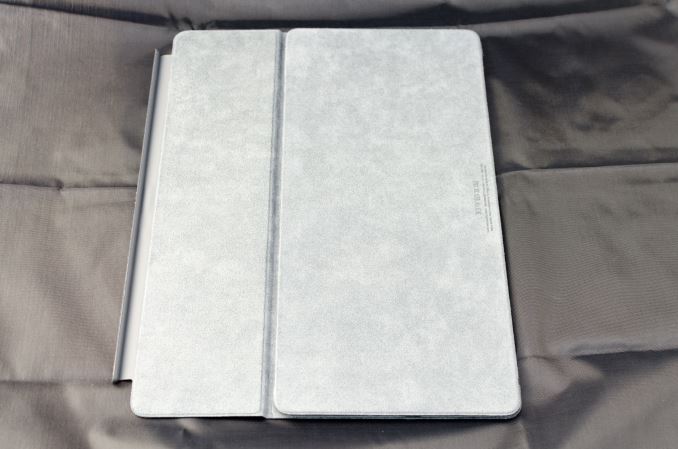
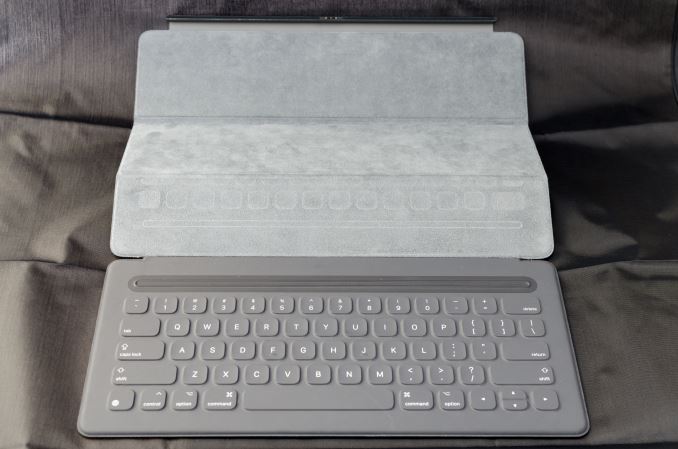
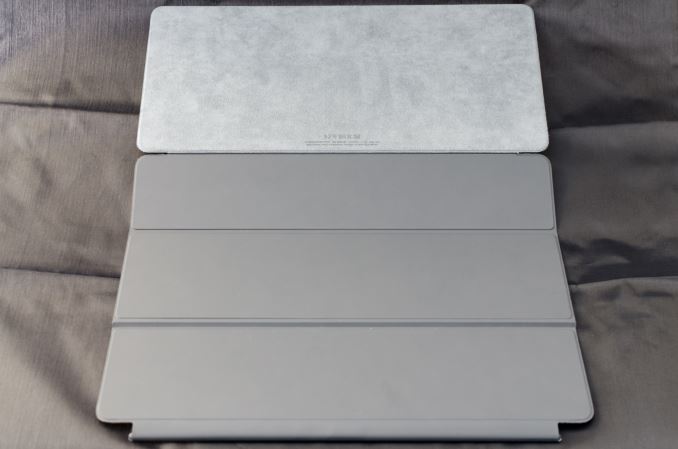
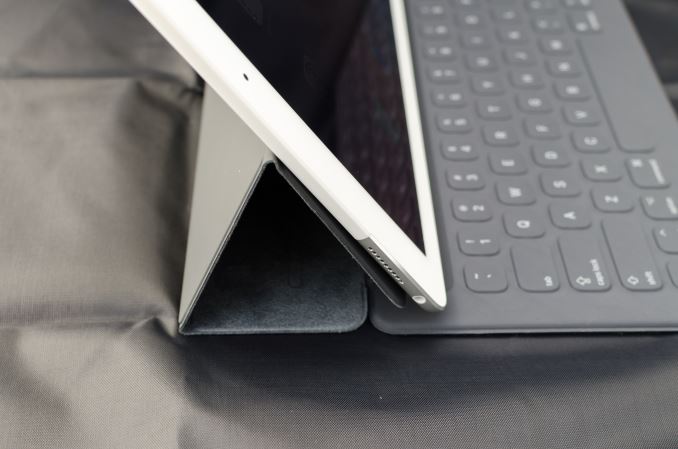
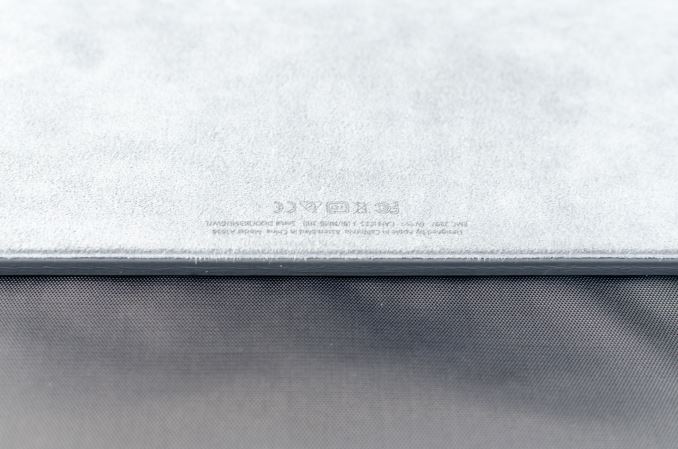








408 Comments
View All Comments
FunBunny2 - Saturday, January 23, 2016 - link
-- It's by now become a quasi-religious belief system for some that "mobile devices cannot ever be used for any professional purposes whatsoever!".despite what some think, Apple didn't invent the tablet. warehouses and manufacturers (when the US had them, of course) have used tablets with 802.11, and earlier protocols, for decades. all Apple did was create a consumer version.
Constructor - Saturday, January 23, 2016 - link
A "version" which "consumers" (apparently intended as a belittling epithet by you) can use, but the whole point is that it's not limited to that.akdj - Monday, January 25, 2016 - link
"You will still never be able to fit Photoshop's whole interface and abundance of options and menus into the tablet in a way that the user is easily able to reach them, without scrolling through pages of big buttons."Huh. Wonder why folks. The professional ones, for years have been buying Wacom tab companions to their 'workstation' specifically FOR PS, And EXACTLY for the reasons you outline, the ability to have precision touch and capacitance/tactile feel and response of real pencil or pen to paper. Some of these Wacom Photoshop controllers cost several times the price of the iPP for YEARS, & the iPP has its computer built in! No need to add a 'workstation'
You must've been hiding under a rock the last ½ decade. You've CERTAINLY not visited the App Store in some time. Adobe, Autoideskk Microsoft and the BIGGEST makers of "Content Creation" software are currently devoting MORE resources to mobile programming and development than their 'workstation' counterparts.
The 'big brow box' filled with diseases,; viruses - malware, adware, & the ilk's days are numbered. They're already on their way out of MANY folks' homes and offices being replaced by ultra books, passively cooled and ultra low voltage with ultra high efficiency is all the rage today. Battery life > 5 extra FPS, usability and funtionality > pure power, lotsa RAM, and expensive CPU and GPUs. Portability and the ability for 'instant on' access to their tab or phone > waiting til home, turning the power on, waiting for the boot. Opening PS (a slowly dying program with a phenomenal amount of alternatives on an iPad and iPhone and iDevice -- been that way for years, now with Adobe on board, their CreativeCloud suite offers a plethora of companion apps capable of ALL CS6's abilities as it's designed to aggregate and integrate with 'your' CC assets allowing for MOST editing ANYone will ever need on the iPad ...especially now with the display's ability to work with such an excellent active stylus and it's near direct comparison to Wacom's line of ...apparently unnessasary PS instruments and tools over the last decade or two those 'productive individuals' have made many millions of dollars in publishing? Now an AIO system with its OWN computer built in - a massive community of developers, independent to Adobe, friend next door or Autodesk themselves --- any software company interested in future survival in the industry is devoting more resources than ANY point in history to mobile dev. It's why MS, Adobe and AD were all there at the iPP unveiling. ALL demonstrating some phenomenal --- and yes, PROfessional use-case applications and software. I'm not a doctor but downloaded the examples shown at its unveiling of the Human Body atlas and AutoCAD --- its mind blowing how easily and flue to the iPad is able to manipulate such extensive detail and graphic overlays (nervous, muscular, skeletal, circulatory system overlays --- in any combination and with the ability to manipulate the direction you're looking at at a consistent 60fps) are MUCH better teaching aids - and learning that ANY static text book
Whether you ARE creating, flying a jet filled with passengers, entertaining a couple thousand folks at a concert, controlling inventory or filing your flight plan a personal pilot --- and probably 100,000 other occupations have been made significantly easier to accomplish, with less weight, more time away from the charger and 110v. That's what people need, want and are looking for. Unfortunately for Apple, they're making their iPad 'too well' --- as I've got the original, and an iPad 2 that both work, hold a charge and last as long as the Day I bought them six and five years ago respectively this year.
I also own the Air 2 and iPP and both have significantl impacts on my business I've run for nearly thirty years, successfully and exponentially dropping 'weight' every decade or so with something as capable as the always on, always connected and never a concern with battery life --- as the iPad is, easily replaces hundreds of dozens of crates of vinyl records! All while weighing about as much as a single - double record LP.
So, to summarize at the end of the day if you're a Photoshop user, you just got an incredible tool to augment your worlflow, make your photographic post production easier, organization and metadata handling, batch alteration or editing and aggregation of your library, metadata in tact and ready for post when you get home. No more off loading memory cards, organizing memory cards, redundantly dumping them for redundant/backup purposes and all the other BS that goes into using a dinosaur of a program FEW truly NEED for their projects.
Today, Adobe offers a ½ dozen "Photoshop" apps on iOS. Along with drawing, marking PDFs, even Premier and AE capture and integration (w/motion) - the options are becoming more extensive everyday, Adobe's just rewrote their entire app library and replaced each app for even better continuity for those still needing PS's tools or Acrobat's abilities beyond the $3, $5, $10 alternatives ...some, like Pixelmator, cross platform with ANY & EVERY PS tool the average layman could dream of --- available - @ the cost of a single month rental of PS/Lightroom 'rental'. And not just for hobbyists. Spend some time at DPreview.com to see the PS competition OR see Adobe's subscription tactics to maintain revenues.
It's not just a super powerful tablet. It's that and so much more thanks to an extensive and larger library of accessible software already matured to the point the App Store is - all in one place and all reasonably priced. Best prices and selection of software in history is currently more convenient and organized than ever and it's in the App Store
As devs have only had single GB of RAM, slower SoCs and smaller displays to program to over the last six years, even the Air 2 & 6s line of iPhones seems HUGE right now with double the RAM, graphics and compute. Double it again and you've got tether iPP. I'm already seeing apps available for Air 1/Mini 2 - 5s or A7/64bit iPads and newer to run the app.
As a daily user of the iPP for two months --- so many of your goofy statements make no sense, shout ignorance and beg to be straightened out --- but there's always a few schills around these parts beating an incredible product down while the masses of us are enjoying it!
Silly Murloc. What is it that makes YOU a Pro, and why is it YOUR job wouldn't be made easier or convenient with a tablet?
jlabelle - Thursday, January 28, 2016 - link
" now with Adobe on board, their CreativeCloud suite offers a plethora of companion apps capable of ALL CS6's abilities as it's designed to aggregate and integrate with 'your' CC assets allowing for MOST editing ANYone will ever need on the iPad"a very big big rant that just fall flat because of false premises. The claim above is a good example : simple case that most photographers need : Can I develop my RAW files on an iPad ?
When I mean developing, it is the normal basic reasons why you are shooting RAW in the 1st place : 1/ work in 16 bits mode so that you can push shadows / pull highlights and work on color without posterization ; 2/ apply automatically the lens correction (distorsion, CA, vignetting, ...) and 3/ have a color managed workflow (take into account the color space of the RAW file, have a calibrated display...)
The answer is ... drums rolling : you can NOT.
And you do not need a CS subscription to do that on a Surface, you can just purchase once Capture One Pro, DXO Optics... what you want. So what you can do with a Windows tablet, you simply cannot on an iPad Pro.
This is just one example but the same is true for a list so long that it makes no sense to try argue against that.
Gastec - Monday, January 25, 2016 - link
A gamer you would know what Pro moniker means.It goes like this: "I'm a Pro, gamer or whatever" meaning "I'm a big shot, a slick, better and cooler that you". And that's what iPad means when it says it's "Pro" :)
KPOM - Friday, January 22, 2016 - link
What do we need all the ports for? Most people, even in offices, can get by with wireless networks and printing these days.xerandin - Saturday, January 23, 2016 - link
Quadro*rabastens23 - Friday, January 22, 2016 - link
"Performance is better than a high end workstation from 10 years ago, a system which was capable of running professional tasks which are still nowhere to be found on mobile platforms."That's sort of an odd claim - what are those tasks, exactly? And if it's not a performance issue, why do you need an iPad Pro to do them?
ddriver - Friday, January 22, 2016 - link
Design, engineering, content creation. Basically every scenario that involves making something professionally rather than consuming something.Nobody needs a ipad pro to do this, point is the device is powerful enough for such tasks, and it would be nice if there was the software for it, in order to make that device truly PRO as in useful to professionals and not "pro" as in an empty marketing BS.
lilmoe - Friday, January 22, 2016 - link
DUDE. Software is NOT the only thing the iPad "Pro" is missing for it to be a Pro tablet. Get this through your head.The hardware is lacking even if it were much more powerful. The OS is also lacking.